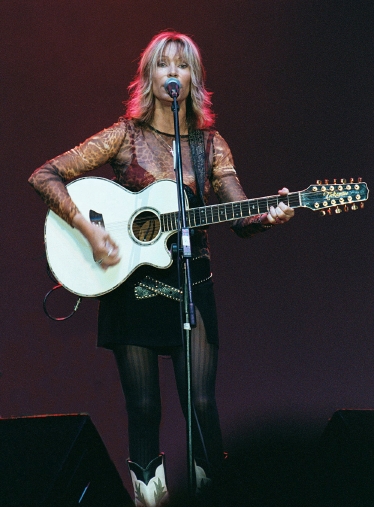
Joni Mitchell In The '70s
The music industry can dent anybody’s enthusiasm and willingness to make art. But a true artist always keeps at it, not only because it is the only valid form of expression he knows, but because he realizes there comes a point his public needs him to articulate how they feel. It becomes something wholly reciprocal; they need each other, they feed off each other and they motivate each other to do their best.
That is the true moral that arises from Joni Mitchell’s career – a career that has seen wild commercial up and downs, but that has had Joni true to herself and to every single one of us.
Joni Mitchell was born Roberta Joan in Fort MacLeod (Canada). The year was 1943. She showed a precocious interest in music, studying first the piano and then the guitar. Yet, at age nine she was stricken with polio. That made playing the guitar difficult from that point onwards, and that was one of the reasons Joni developed the unique tunings she would be renowned for in her career.
She has defined herself as a “rebellious teenager”, and upon growing up she intended to attend art school in Calgary. She attended classes only for one year there before moving to Toronto, where she met a cabaret jazz singer named Chuck Mitchell that would become her husband in 1966. Together, they headed for the US to seek their fortunes as musicians. The marriage fell apart in 1967, and Joni went to New York City to launch her solo career in earnest.
Before ever releasing her debut album, other artists began recording her songs – Tom Rush sang the very first song she ever wrote, “Urge For Going”, and Judy Collins made the poignant “Both Sides Now” popular long before Joni did.
Joni’s big break came when she was discovered by David Crosby, who convinced his record company (Reprise Records) to sign her up. They did, and Joni’s first album (known as either “Joni Mitchell” or “Song For A Seagull”) was recorded and issued. Public interest began picking up, and a heavy schedule in support of both her debut and the follow-up record (“Clouds”, 1969) made the press take notice as well.
“Ladies Of The Canyon” was issued in 1970. It became her first gold record on the strength of “Big Yellow Taxi” (a top 30 hit) and her own version of “The Circle Game” (the song had been recorded long before by both by Tom Rush and Buffy Sainte-Marie).
But Joni became a true sensation with the release of “Blue” in June 1971. The album set the scene for the confessional music that was so popular in the ‘70s (as exemplified by albums like Dylan’s “Blood On The Tracks”), and it featured all the ingredients that would make her a legend in the exact proportion: her trademark guitar playing, her hypnotizing contralto vocals, lyrics that were incredibly personal and yet completely relatable… “Blue” was followed by the mega successful “For The Roses” (1972) and “Court And Spark” (1974). Together with “Blue”, these albums marked her commercial peak. “For The Roses” yielded “You Turn Me On, I’m A Radio” (it hit # 25) and “Court And Spark” included her only Top 10 single ever, “Help Me” (it peaked at # 7).
“Court And Spark” was also notable because Joni began introducing elements of jazz into her music, and (beginning with “The Hissing Of Summer Lawns” in 1975) she would embark on a period of experimentation with the genre that gradually alienated her original following. And it must also be mentioned that she made no fans among jazz lovers. Her 1979 collaboration with legendary jazzman Charlie Mingus was especially disdained, and it was her first album not to go gold since the ‘60s. The narrow-mindedness of the public frustrated Joni to no end, and the ’80 were to be times of commercial apathy. Although she revisited her pop music roots, albums like “Dog Eat Dog” were marred by synthesizers and production values that were entirely at odds with her traditional approach to music.
The ‘90s saw a true comeback in the shape of the “Turbulent Indigo” album (1994), and the decade was occupied by plenty of parallel projects. Several compilations of different nature were released: a “Hits” and a “Misses” album, an album of jazz standards, an orchestrated anthology…

Joni Mitchell Playing Live In The Late '90s
Come the year 2002, and Mitchell announced a retirement based largely on her discontent with the music industry. However, she issued “Shine” in 2006, an album that hinted at the intimacy of some of her best work.
But Joni’s retirement became permanent upon being diagnosed with Morgellons Syndrome in 2010. She has announced her intent to leave the music industry and focus all her efforts on using her prominent position in society towards benefiting people who live with such a syndrome.
That doesn’t mean she won’t make music any longer, of course. The context will be different. Joni has looked at everything from both sides now. She has felt everything from both sides now. She knows that every circle game comes to a close. But that’s just right in the end. A closure is the only way something new can come to be. When her work is done, when the circle she has created is finally perfected, so many will start drawing their own based on what she did. So many have already started doing it, actually. And that’s the ultimate testament to an unparalleled life of art, passion and belief like the one that she has led.

Pingback: Month In Review – August 2010 | MusicKO
Pingback: Un Accidente Feliz (Lucas Meyer) – Uruguayan Independent Artist | MusicKO